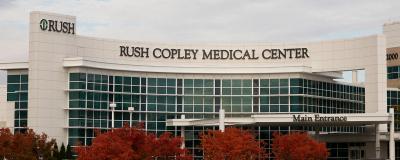About Rush Copley Inpatient Physical Rehabilitation
The opportunities of Rush Copley's Inpatient Rehabilitation services are unique and expansive. Some of the special features include the following:
- The Inpatient Physical Rehabilitation Center/Therapy Gym: The Center is designed to maximize patients' potential as they return to independence. The therapy gym offers true-to-life features such as an automobile designed to replicate day-to-day activities. As part of therapy, patients use the gym to practice walking and lifting and perform exercises to help strengthen muscles and improve basic body movement. Inpatient therapy is provided six days a week for at least 3 hours.
- Animal-assisted therapy: Animal-assisted therapy is provided as an adjunct to traditional therapy sessions. Our program facilitates improved clinical outcomes for therapy goals and interventions, increased motivation, as well as improved patient satisfaction among patients on the rehab unit. Through interaction with specially trained dogs, patients are able to reach their rehabilitation goals in an innovative and enjoyable setting.
- Virtual Reality Augmented Therapy System: The OmniVR® is the world’s first 3D Virtual Reality Augmented Therapy system designed specifically for individuals with physical limitations. The technology is a new tool for physical, occupational and speech therapists to help improve function, through participation in a variety of therapeutic activities and exercises that are selected for the individual’s physical challenge or condition while having fun. These exercises and activities have been developed around evidence-based literature addressing the techniques and objectives of accepted therapy practice.
- Cognitive software: Rehabilitation is enhanced through use of computer software programs that provide cognitive exercises to enhance attention, reasoning, memory, listening skills, and cognitive processing speed. Our therapists utilize this technology to improve and retrain cognitive function through a fun and challenging activity.
- VitalStim therapy for swallowing dysfunction: VitalStim is a treatment used to help patients who have difficulty swallowing. Therapists are certified to provide VitalStim to assist with improving swallow function. Electrical stimulation is used to aid in muscle strengthening to improve the patient’s swallowing function. This intervention has been shown to accelerate recovery.
- Fiberoptic endoscopic evaluation of swallowing: Speech language pathologists are skilled in the use of fiberoptic technology to assist in assessing swallowing function. Utilizing this form of assessment for swallowing provides immediate results for recommendations and treatment. This assessment can be completed in the patient's room and is helpful to assist in determining the patient’s readiness for oral nutrition.

